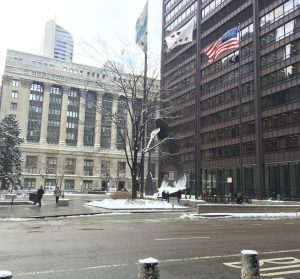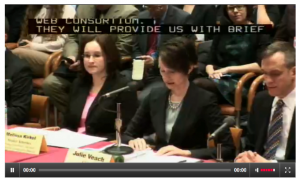by Ed Finkel of LISC/Chicago’s New Communities Program
July 21, 2008 – The building on west North Avenue stands out from its neighbors due to its mostly glass first-floor façade and the only sidewalk tree on the block.
The inside feels like a modern college dormitory, with a study room to the left, a sun-splashed kitchen in the back, an entertainment and exercise roomhttp://www.newcommunities.org/cmaimages/LaCasa-backyard.jpg downstairs, and eight modest bedrooms along with two bathrooms on each of the second and third floors.
Although it functions as a college dorm for some residents, this facility, the aptly named Solid Ground Supportive Housing Facility , exists to provide transitional housing for formerly homeless young men ages 16 to 21.
Landon Bone Baker, the architectural firm that handled a nearly $1 million gut-rehab on the building with a mix of public and private funds, received a Chicago Neighborhood Development Award in February from LISC/Chicago.
“It looks like an apartment building, but a nice, neat, new one,” says Sol Flores, executive director of Solid Ground owner and operator La Casa Norte, a Humboldt Park New Communities Program key partner agency. “Some buildings on North Avenue are not in the greatest shape.”
Apparently none on the same block has been rehabbed – the sidewalk tree grows out of newer city Department of Planning and Development regulations.
On this Tuesday in June, newly purchased cuts of meat are splayed across the kitchen counter as a newly minted Truman College freshman sits down to enjoy a grilled chicken Caesar salad for lunch.
Flores gently chides another resident for borrowing an item from the office without asking – and then enthusiastically congratulates him on his pending graduation from an automotive technology program. “That’s exciting!” she says. “We have to have another ice-cream party.”
Solid Ground aims to provide these young men — some of whom have been physically or sexually abused, some of whose parents are in jail, dead, homeless themselves, or substance abusers — with the stable, nurturing environment they have lacked.
Founded in 2002, La Casa Norte began with a crisis center and job-skills “university” before moving its main offices a few doors down the street and opening the housing four years later, with the aim of building skills and resulting self-reliance and independent living.
“It’s hard to do housing if you’re a new organization – who the hell are you?” Flores says. Youth can stay for up to two years or through their 21 st birthday, and by the time they leave, “they know what it takes to get their apartment going,” a skill set that includes supervised cooking sessions in the kitchen, she says.
The 16 residents range from high school and college students to those working toward their G.E.D. or looking for work. “They have to be doing something,” Flores says.
To that end, the second and third floors of the building are locked during the day, and the television and videos in the basement are off-limits until 3 p.m. to model schedules and routines. “We’re trying to do all that modeling they didn’t get at home,” she says.
The basement presented perhaps the largest challenge during the gut rehab, which went “from the dirt in the basement to the heavens,” Flores says. Once a “scary Chicago basement,” the floor was dug three extra feet to create a decent height for the ceiling.
It now feels downright homey, with a computer area and laundry in addition to the rec room, where a poster board asks, “Are you saving for your own apartment?” and a mural sports larger-than-life likenesses of Malcolm X, Frida Kahlo and Langston Hughes.
The second and third floors have eight bedrooms and two bathrooms apiece; the building was extended onto what had been a back porch to fit them all, part of what led to a year-long zoning and permitting process.
“It’s like you grew up in a large family,” Flores says. The bedrooms are small, some as little as 72 square feet, but they’re perhaps the first private space these young people have had, which she considers an important element of the maturation process. Most have loft-style beds with a desk underneath.
Youth use the first-floor conference room for studying, practicing music and other purposes, says Dulce Quintero, program supervisor. “The kitchen, being on the main floor, ends up being the meeting area,” she says.
The backyard contains a tile mosaic designed by the non-profit youth art group archi-treasures, and the front façade soon will become a bit more noticeable when it features an image of a man transforming into an eagle. “It will symbolize the strength of young men,” Flores says.
Residents all start out being evaluated through La Casa Norte’s crisis center, and those who aren’t a fit for the housing facility still can receive the other services. All clients can participate in the Casa Tera U., where they learn or augment computer skills.
“I appreciate the opportunity,” says a young man named Chris. “My room’s not that big, but it’s decent. The fire escape is not a ladder you have to throw down.”
“Life’s been better than what it was,” says another resident, Danny. “If you complain about something, they improve it. … There’s a chillin’ apartment there, [and] everybody gets along. The space is still pretty fresh, compared to places I’ve been.”
“It’s not family, but it’s close to it,” says Lonnie, another resident. “The staff is compassionate and interested in helping you.”
“They’re so cute,” Flores enthuses after the three file out. “Self-expression – just coming into your own.”
No staff live in the building, but at least one professional youth worker is on duty 24/7. The curfew is 2 a.m. for those ages 18 and over, and the late-night and early-morning staff often consult one-on-one with those who need an ear about personal issues.
Residents are free to spend Friday or Saturday nights elsewhere, with prior arrangements, but no visitors are allowed at Solid Ground.
“It seems harsh,” Flores says, but that way, “You always know who’s going to be here. It’s no one you have a history with, or someone with gang ties.”
The agency faced NIMBYism at first and is very conscious of building community relations, Flores says, striving to be low-key – but not invisible. “We try to control the noise at night in the back,” she says. “We also don’t want to hide that we’re here.”
La Casa Norte would like to expand its housing offerings to include spaces for teenage girls and young women, and for families, Flores says.
“There is no other special-needs housing for young people in Humboldt Park ,” she says. “It brings attention to the issue, kids who fall through the cracks. We want the community to see the importance of it.”

![Reblog this post [with Zemanta]](http://img.zemanta.com/reblog_e.png?x-id=a02859c0-63e5-4009-ac64-1408c862244e)





Be First to Comment